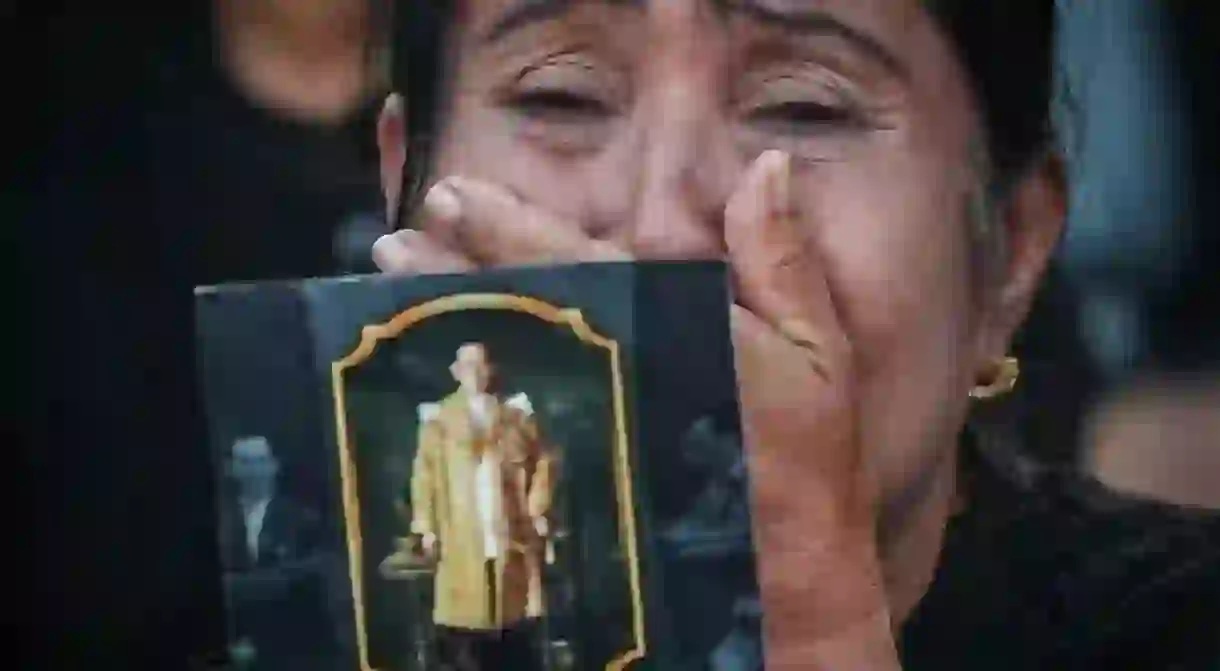See Thailand Like Never Before as Millions Mourn King's Death

On Thursday October 26, 2017, the late King Rama IX of Thailand was cremated after one year of mourning and reflection. As part of a five-day, US$90m funeral, an entire nation came to a standstill – paying their respects to their beloved monarch.
Phra Meru Mas, the golden royal crematorium, was constructed specifically for the cremation ceremony at a cost of US$30m. As per centuries of Thai tradition, its design represents the palace above Mount Meru (the centre of the Buddhist and Hindu universe), and the place Thais believe their royals ascend to after death. Ten months in the making, standing at 165 feet tall, the crematorium will be open to visitors from November 2 to 30 – after which it will be dismantled.

The royal chariot brought the urn to the funeral pyre, passing crowds of mourners who lined the street along the way. Many mourners camped out for several days in order to reserve a good spot to watch the procession and pay their respects.

Rama IX was commonly referred to as the ‘father of all Thais’ and was widely loved and respected. Tears were shed by many people in attendance, and by the millions attending events in provinces around the country.

Once the funeral of the late king is finished, the coronation of his son Vajiralongkorn, or Rama X, can go ahead in December. At age 65, he will be the oldest Thai prince to ascend to the throne. He was tasked with lighting the funeral pyre, to begin the cremation process.


Once the royal chariot carrying the urn arrived at the crematorium, foreign dignitaries and guests laid offerings of sandalwood flowers – an act that was repeated at venues throughout Thailand. Some time after 10pm on Wednesday, King Bhumibol Adulyadej, the 9th king of the Chakri dynasty, was cremated.

Mourners clutched portraits of their late king as a mark of respect as they walked the streets of Bangkok, in scenes reminiscent of the time the king was in poor health, shortly before his death. Only a few thousand made it to the site of the crematorium, with the rest having to make do with watching from wherever they could.



As well as transport services offering free or discounted travel on the day of the cremation, many shops provided free food and water to the mourning crowds, most of whom endured high temperatures and torrential downpours during their vigil.


Bangkok’s Khaosan Road, usually teeming with tourists, attracted a different crowd. With its close proximity to the site of the cremation, it quickly became filled with passing crowds – a change from its usual backpacker clientele.

As well as in Bangkok, up and down the country Thais watched the events unfold on their screens as footage was broadcast on all television channels. In the weeks leading up to the funeral, entertainment shows were curtailed and broadcasts were made in black and white. Many shops and businesses closed for the day in order to give their staff time to watch the funeral and pay their respects.


Major roads were pedestrianised in order to ensure the safe and orderly movement of the mourners towards the site of the cremation, and many attractions were closed for the day.



Some 80,000 security personnel were on duty, in order to keep order and peace. Additionally, drones were forbidden not just from flying within 19km of the site of the cremation, but also from going over the replica crematorium sites around the country.

As well as road closures, there were restrictions affecting the Chao Phraya, with boats for both mourners and tourists restricting where they stopped. The Chao Phraya Express boat was operating for free, so as not to take advantage of people mourning the loss of their king.


The weather ranged from hot to rainy throughout the day and some members of the funeral procession fainted due to the heat and their warm outfits. However, the rain did little to deter those who came out in their thousands to witness the events.

Thailand is a majority-Buddhist country, and so those religious traditions featured prominently in the ceremony. Thai males are encouraged to join the monkhood as some point in their lives, and Rama IX spent 15 days as a monk in 1956 following the death of his grandmother.

Since the king’s passing on October 13 last year, over 12 million people have visited the Grand Palace to pay their respects.
Funeral proceedings are set to continue until Sunday 29 October, where the king’s ashes will be finally laid to rest in the Royal Crematorium













